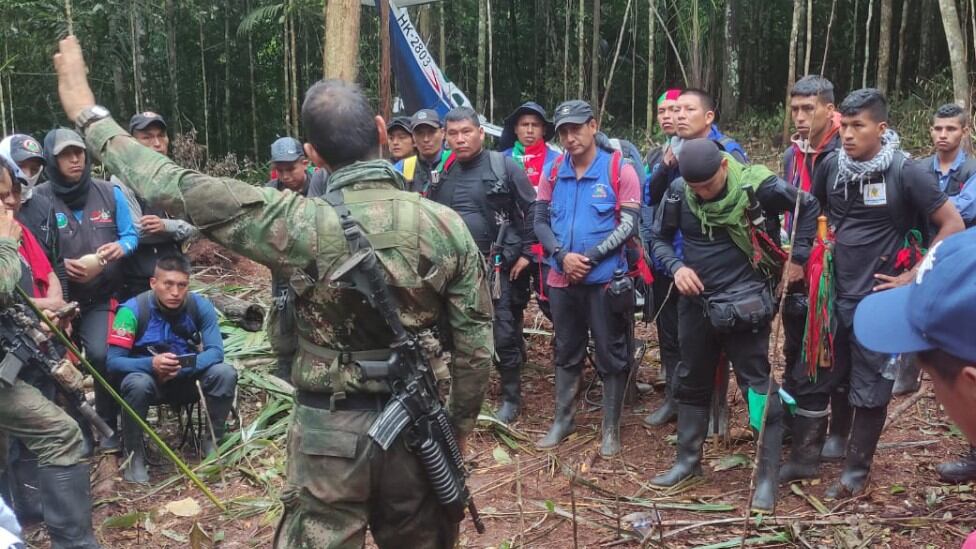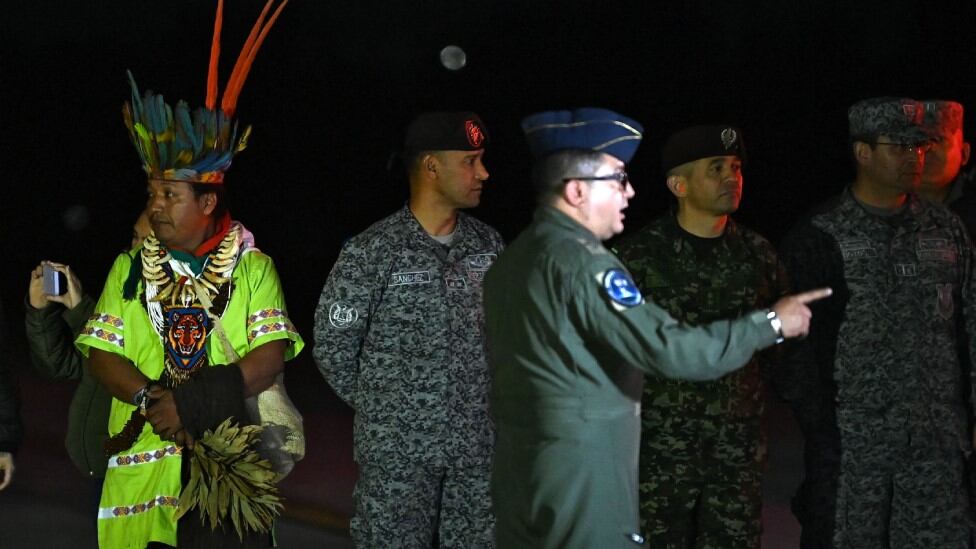The operation relied on state-of-the-art technology and ancestral knowledge. Hundreds of soldiers and indigenous guards. Helicopters, planes. Horns that called them with the voice of their grandmother. The rescuers traveled 2,500 kilometers in a specific space. And nothing. The children remained missing for 40 days.
The four indigenous children were finally found on Friday in the remotest part of the Colombian Amazon jungle.
LOOK: “They asked me for bread with sausages”: the new details about the rescue of children in the jungle of Colombia
On May 1, the plane in which they were traveling with their mother crashed. Only they were left alive, but without food, without a roof; in a dark jungle, full of wild animals.
Fabian Mulcue He is one of the members of the Indigenous Guard who took part in the operation.
He comes from Cauca, a region other than the Amazon. He was there 15 days. He saw the environment where the children were up close. And it is not explained how they could not find them.
Back in Cauca, Mulcue spoke to BBC Mundo by telephone about the operation, the theories about how the children survived and what he learned from the Amazonian indigenous people and from the soldiers of the army.
______________________
What was your role in the rescue operation?
I am a leader of the Regional Indigenous Council of Cauca. Two days after the plane crashed, they called me and asked me to put together a group to help with the rescue.
We were 40 fellow guards. We met about 20 Uitoto guards, who are from Caquetá. We got into three helicopters. Some last 15 days, others more or less. It was changing, and the most impressive thing is now to think that those children were there.
Because looking at that jungle is like looking at the sky, it is a space that never ends. And when we arrived, a downpour fell, drenching us from head to toe.
How is the jungle?
It is a jungle that cannot be explained. It rains all the time. You can not dry things from moisture. Many voices, sounds, noises are heard.
On the first night we woke up full of cattle ticks. Another day it was termites.
Some soldiers were talking about how this is a green hell. And I understand them.
At night you hear the cry of the leprechaun, situations that one does not see but feels.
There are very big trees. The jungle alone is very high and dark.
You passed three times where the children were finally found. With such a large operative, why was it so difficult to track them down?
That is what we ask ourselves. One could tell that they were watching us. Because it is not understood that, with all that we traveled, we found them where we had already passed.
We walked 10 kilometers a day each. The army had all the technology.
We found the ribbon, the scissors, other traces, but nothing that appeared.
Compasses don’t work in that place: they get out of calibration. And sometimes the traces they left behind were very faint; they left no footprints because their feet were wrapped in cloth.
One day, at 7:00 am, we went out for a round and heard a child crying.
We wanted to surround it, as if we were going to catch a chicken, and we found traces, that they ate mojojoy, palm, that they drank water, but at that moment it rained, and that there when it rains you can’t see anything, it’s time to stop and we couldn’t move forward.

Do you think maybe the children were hiding?
What the grandparents of their community told us is that the duende was hiding them. And with that information we were able to reach one of the caves where they were.
But the truth is that you have to close your eyes and imagine a movie, because that’s the only way to explain it.
Who is the leprechaun?
For the exercise of the jungle, it is a spirit that is represented in a person or in an animal. Can be anything.
What techniques did you use to search?
There were several, including the sweep of the comb, which is that every 10 meters someone opens and then closes. And from the other side comes another group. It’s like a zigzag from both sides. It covers the entire space.

What did they learn from the soldiers in the army?
We learned from their technology strategies. Some of us did not know how to use the compass, the satellite phone, the military rations.
We did not know his capacity for a sense of belonging. There was a commando that slipped and his mouth was punctured and he almost lost his eye. There was another who cut his testicles.
And despite these difficulties, they continue, and they speak in the sense that they can be our families.
And do you think they learned something from you?
Clear. First, I think they realized that we can coordinate and that they can read the environment with our tools.
Although we are not from that region, we know about the plants, the food, what can and cannot be done in the jungle, what animals are wild, what others to eat.
In the life of the soldiers there is always a ration and they collect water to boil. But they do not contemplate the plants. That is a teaching.
And of course, for us it was also a lesson to learn from our indigenous compañeros from the Amazon.

Why do you think the children were spared?
First, the courage and ability they have had to live in areas like that. The Araracuara (area of the Uitoto community) still has a large part of the jungle. Over there they play hide and seek, games that consist of entering the jungle.
Also the rations that family welfare threw away. It was a big mess. One of those rations was found.
They had moisturizing serum, fariña, cookies and a panela. There was also a lighter and we found no trace of fire, and that is because in those conditions it is very difficult to light a candle. And they didn’t take the serum.
If you and the soldiers were injured, one imagines that the children were too.
Clear. But they took the first aid kit from the plane and they did heal each other.
Since they (on the flight) were going to live in Villavicencio (a city they would move to), they brought many things, including an awning. And they took two suitcases, took out the notebooks and left what was necessary.

Some Colombians think that the Indigenous Guard is a terrorist, allied with the guerrillas. What do you think of that now?
Well, it was an experience realizing on the ground that those who think like this are only a few. The soldiers told us that they had never been in this situation.
That they had been told that the Guard was the column of the guerrilla. And, they said, “for us coming to this jungle and talking with you is something unique.”
They’ve been told for years that they can’t talk to us and now we were eating together.
This experience allows us to show that we are on the humanitarian issue. We are going to continue accompanying the air force, the army, family welfare.
There they saw us with our symbols, with our pots, and they themselves wondered why we were so stigmatized if we can work together.
In the last two nights the tiger was around us up to 20 meters away. I had never heard of a tiger and we saw that together.
And the lesson is that you have to take care of the jungle and it is everyone’s responsibility: soldiers and guards.
Source: Elcomercio
I am Jack Morton and I work in 24 News Recorder. I mostly cover world news and I have also authored 24 news recorder. I find this work highly interesting and it allows me to keep up with current events happening around the world.

:quality(75)/cloudfront-us-east-1.images.arcpublishing.com/elcomercio/EAJ5O7XY5BFAPMF6YYPJIG6MOE.png)





